eISSN: 2093-8462 http://jesk.or.kr
Open Access, Peer-reviewed

eISSN: 2093-8462 http://jesk.or.kr
Open Access, Peer-reviewed
Wonsup Lee
, Heecheon You
10.5143/JESK.2022.41.6.547 Epub 2023 January 02
Abstract
Objective: A novel method based on body shape for the generation of representative human models (RHMs) was proposed in the present study for ergonomic product design.
Background: RHMs of a particular population are required to satisfy the representativeness of a target population under consideration in ergonomic product design. A conventional RHM generation method based on key anthropometric dimensions has limitations in terms of the representativeness of RHMs and consistency between RHMs.
Method: This study proposed a method of shape-based percentile RHM generation using template-registered 3D body images. A point cluster containing all 3D body images of a particular vertex is projected on a vector passing the origin point and the average location of the point cluster; then, a percentile location of the point cluster is calculated. Then, a percentile RHM is generated by forming a triangular mesh structure based on the percentile locations of all the vertices. Lastly, the generated RHM is adjusted in terms of its size by referring to anthropometric measurements.
Results: The RHMs generated by the proposed method showed better representativeness for ergonomic product design as well as better morphological consistency between RHMs as compared to the conventional method.
Conclusion: Compared to the conventional method that chooses a few cases from a large number of 3D body scan images in a database, the proposed method uses all the 3D scan images in a database to generate RHMs.
Application: The proposed method can be applied for the ergonomic design of wearable products such as facial masks, glass-type or goggle-type products, industrial protective devices, sporting goods for athletes, medical prosthetics, and assistive tools.
Keywords
3D body scan data Representative human models (RHMs) Percentile RHMs Ergonomic product design
인체측정학적 데이터를 인간공학적 제품 설계에 효율적으로 적용하기 위해 특정 인구 집단의 크기 및 형상의 특징을 소수의 대표인체모델(representative human model)로 나타내는 방법이 활용되고 있다. 대표인체모델은 주로 일부 인체 크기(예: 중요인체변수) 측면에서 특정 치수(예: 평균, 평균 표준편차, 백분위값, 경계부위 치수)를 가지는 사람으로서 선택된다(Jung et al., 2021a; Lee et al., 2011; Lee et al., 2019; Lee et al., 2018). 머리에 대한 대표인체모델 연구로 Lee et al. (2018)은 머리에 착용하는 제품의 설계를 위해 Civilian American and European Surface Anthropometry Resources (CAESAR) 데이터(Robinette et al., 2002)에서 측정된 30개의 머리 치수들을 이용하여 최적의 치수체계와 각 치수를 대표하는 두상을 생성하기 위한 시스템(3D Anthropometric Sizing Analysis System; 3D-ASAS)을 제안하였다. Zhuang et al. (2010)는 미국 노동자 3,997명의 머리 관련 치수들을 기반으로 미국의 산업용 마스크 설계에 활용하기 위한 5가지 대표 두상(small, medium, large, long-narrow, short-wide)을 제작하였으며, 같은 방법으로 Yu et al. (2012)는 중국인 노동자 3,000명의 머리 데이터를 이용하여 중국인을 위한 5가지 대표 두상을 제작하였다. Lee et al. (2021)은 한국인 공군조종사의 얼굴 크기 및 형상 특성에 적합한 조종사용 산소마스크를 설계하기 위해 336명의 한국인 공군조종사의 3차원 스캔 데이터를 이용하여 4가지 대표 얼굴(small narrow, medium narrow, medium wide, 그리고 large wide)를 도출하고, 이를 산소마스크 설계에 활용하였다.
기존에는 몇 가지 중요인체변수들(key anthropometric dimensions)의 백분위 값을 이용하여 대표인체모델들의 크기를 정하는 방법이 주로 활용되고 있으나 대표인체모델 간의 형상적 일관성 및 선택된 모델의 대표성 측면에서 한계가 있다. 모든 세부적인 인체측정항목들 측면에서 특정한 크기(예: 5%ile 크기)를 갖는 사람을 주어진 데이터베이스(예: 사이즈 코리아 3차원 인체 스캔 데이터베이스) 내에서 찾는 것은 현실적으로 매우 어렵다(Jung et al., 2021b; Lee et al., 2019; Lee et al., 2016). 따라서, 설계하고자 하는 제품의 설계 변수와 연관성이 높은 일부 중요인체변수들(key dimensions) 측면에서 대표인체모델들을 탐색하는 것이 일반적이었다(Lee et al., 2019; Lee et al., 2018; Zhuang et al., 2010). 예를 들어, 산소마스크 설계를 위한 대표인체모델을 탐색할 때는 산소마스크를 착용하는 부위와 연관된 얼굴길이, 얼굴너비, 턱너비, 코뿌리너비, 입너비, 코높이 등 측면에 한하여 대표 치수를 갖는 얼굴을 탐색하며, 산소마스크 설계와 관련성이 적은 눈동자사이거리, 최소이마너비, 머리둘레 등에 대한 인체 변수들은 대표인체모델 탐색 과정에서 고려되지 않았다(Lee, 2013; Lee et al., 2013). 따라서, 중요인체변수들에 대해 특정 크기(예: 평균, 5%ile, 25%ile, 50%ile, 75%ile, 95%ile)에 최대한 가까운 치수를 가진 3차원 인체가 대표인체모델로서 선택되었다(Lee et al., 2019). 한편, 중요인체변수에 기반한 기존 방법은 선택된 모델의 대표성과 대표인체모델 간의 형상적 일관성 측면에서 한계가 있다. 일반적으로 사람들 간에 인체 크기와 형상이 서로 상이하므로, Figure 1.a의 예시에서 볼 수 있는 것과 같이, 3차원 인체 스캔 데이터베이스 중에서 선택되는 대표인체모델들 간의 형상적 일관성을 찾는 것도 실질적으로 불가능하다(Lee et al., 2016). Zhuang et al. (2010)은 5가지 치수의 대표 두상들을 생성할 때, 각 치수 별로 대표 크기에 유사한 5명의 머리를 선택한 후 PolyWorks (Innovmetric Software Inc., Canada) 소프트웨어를 이용하여 이들을 겹쳐 평균 형상을 생성하였다(Figure 1.b). 이를 통해, 생성된 두상들의 크기와 형상적 대표성을 제고하고자 하였으나, 대표 모델들 간의 형상적 일관성에는 여전히 한계가 있다. 한편, 일부 중요인체변수들 측면에서 특정 크기(예: 25%ile)에 가까운 대표 인체가 3차원 인체 스캔 데이터베이스에 포함되어 있을 가능성은 있지만, 모든 인체 변수들 측면에서 특정 크기를 갖는 사람을 찾는 것 또한 실질적으로 불가능하다(Lee et al., 2019).
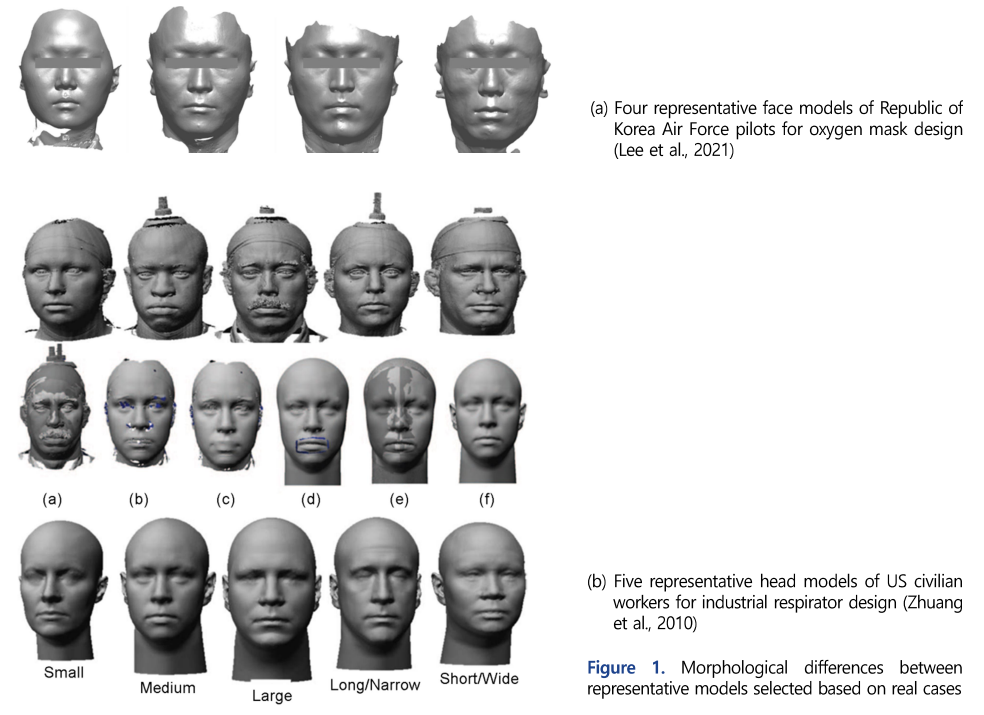
3차원 인체 스캔 데이터베이스를 활용한 형상 대표성 분석을 위해 템플릿 모델 정합(template model registration; TMR)된 3차원 인체 데이터에 주성분 분석(principal component analysis; PCA)을 적용하는 방법이 활용되고 있으나, 특정 크기를 가진 대표 인체를 생성하는 것에는 한계가 있다. TMR은 템플릿 이미지를 대상 3차원 인체 스캔 이미지에 정합시킴으로써 템플릿 이미지가 가진 mesh의 구조를 유지하면서 그 형상은 대상 이미지에 일치되도록 하는 기술이다(Allen et al., 2003; Anguelov et al., 2005; Lee et al., 2017a; Lee et al., 2020a; Lee et al., 2020b). 원본 3차원 인체 스캔 이미지들은 각 형상을 구성하는 vertex의 개수와 mesh의 구성이 서로 상이하지만, TMR이 적용되면 각 형상을 구성하는 vertex 및 mesh 구성 측면에서 데이터의 구조가 동일하게 되므로 TMR된 데이터는 기술적 분석(예: 통계 분석, 기계학습 등)이 가능해진다(Ball et al., 2010; Lee et al., 2017a; Lee et al., 2020a; Li et al., 2017; Luximon et al., 2012b; Zhuang et al., 2013). TMR된 데이터의 모든 vertex의 3차원 좌표(x, y, z)를 입력으로 하는 PCA 분석을 통해 얼굴 형상의 대표적인 변동성이 소수 개의 대표 주성분(principal components; PCs) 측면에서 분석될 수 있다(Allen et al., 2003; Baek and Lee, 2012; Ball et al., 2010; Chu et al., 2010; Lee et al., 2017a; Lee et al., 2017b; Lee et al., 2016; Li et al., 2015; Luximon et al., 2012a; Luximon et al., 2012b; Nerot et al., 2016; Xi and Shu, 2009; Zhuang et al., 2013). 예를 들어, Luximon et al. (2012b)은 TMR된 머리 데이터의 모든 vertex의 3차원 좌표에 대해 eigen vector 방향으로 ±3 × standard deviation (SD)만큼 이동된 위치에서의 3차원 형상을 구현함으로써 주성분별 머리 형상의 변동성 양상을 시각화하였다(Figure 2). 하지만 이 방법은 설계 대상 인구 집단에 대한 형태적 대표 경향성을 시각화할 수 있는 반면, 제품 설계에 필요한 특정 크기(예: 25%ile)의 대표인체모델을 도출하기에는 한계가 있다(Jung et al., 2021b).
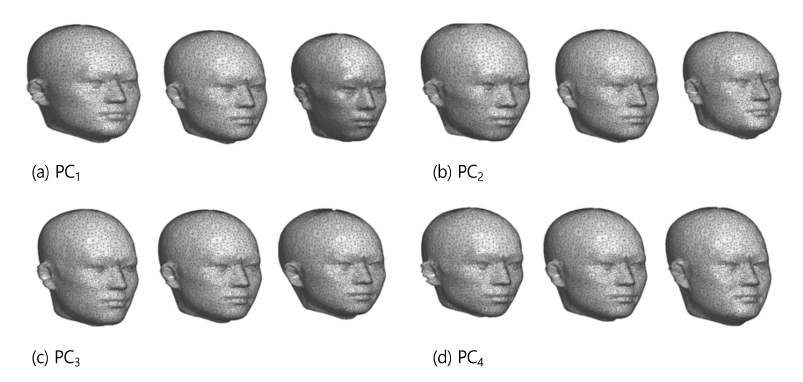
본 연구는 TMR 적용을 통해 mesh 구조가 동일하게 된 3차원 인체 스캔 데이터들을 이용하여 형상 기반의 백분위 대표인체모델을 생성하였다. 본 연구는 선행 연구에서 제안한 hybrid TMR 방법(Lee et al., 2020b)을 적용하여 3차원 인체 스캔 데이터들을 준비하였다. 이들 TMR이 적용된 3차원 인체 스캔 데이터들의 각 vertex에 대한 백분위 위치를 이용하여 형상 기반 백분위 대표인체모델을 생성하는 방법이 본 연구에서 제안되었다. 마지막으로 제안된 방법은 머리와 귀의 백분위 대표인체모델 생성에 적용되어 제안된 방법의 효용성이 고찰되었다.
2.1 Hybrid template model registration
본 연구의 선행 연구(Jung et al., 2021b; Kwon et al., 2022; Lee et al., 2017a; Lee et al., 2017b; Lee et al., 2020b; Lee et al., 2016)는 인체측정학 연구 및 인간공학적 제품 설계에 활용될 수 있는 템플릿 정합 이미지들(template-registered images)을 생성하기 위한 hybrid TMR 방법을 제안하였다. 템플릿 정합 이미지들을 인체측정학 연구 및 인간공학적 제품 설계에 유용하게 활용하기 위해서는 TMR 과정에서 템플릿의 mesh 구조가 대상 이미지들 간에 일관적인 양상으로 정합되는 것이 중요한데, hybrid TMR 방법은 템플릿 정합 이미지들 간의 mesh 구조의 일관성을 제고한다.
Hybrid TMR 방법은 머리의 특정 참조점들을 기반으로 템플릿 이미지의 전반적인 크기와 위치를 대상 이미지에 맞게 대략적으로 조절(global registration)한 후, 세부적인 형상을 정합(local optimization)함으로써 템플릿 정합 이미지들 간의 일관성을 제고하는 방법이다. 먼저, global registration 단계에서는 머리너비(head breadth), 머리수직길이(head length), 머리높이(head height) 측정치를 이용하여 템플릿 두상의 가로, 세로, 높이를 대상 이미지의 크기에 맞게 scaling한 후, 템플릿 모델의 13개의 주요 인체측정 기준점들의 위치를 대상 이미지의 해당 측정 기준점의 위치로 이동함으로써 템플릿 모델의 전반적인 크기와 형상을 조절한다. 이 때, 템플릿 모델을 구성하는 각 vertex들과 참조점들 사이의 관계가 변형 계수(weight; 0 < w < 1)로서 정의되는데, 특정 참조점에 가까이 위치한 점들의 변형 계수는 해당 참조점에 대해 1에 가까운 수치를 나타낸다. 따라서 템플릿 모델의 참조점들의 위치가 대상 이미지의 해당 참조점들의 위치로 이동할 때, 템플릿 모델의 형상이 함께 변형(deformation)된다. 형상 변형은 Jacobson et al. (2014)이 제안한 bounded biharmonic weight (BBW) 기법이 적용되었다. 본 연구는 global registration에 필요한 참조점으로서 13개의 인체측정 기준점들(anthropometric landmarks)을 활용하였다(Lee et al., 2020b). 13개의 인체측정 기준점들 중 눈살점(glabella), 코뿌리점(sellion), 코끝점(pronasale), 코밑점(subnasale), 양쪽 입술가장자리점(cheilion), 앞턱끝점(pronasale), 양쪽 눈초리점(ectocanthion), 양쪽 귀구슬점(tragion)의 위치는 본 연구에서 제작한 인체측정 기준점 표기 프로그램을 통해 파악되었다(Figure 3). 머리마루점(vertex)과 뒤통수점(occiput)의 위치는 대상 이미지의 헤어스타일로 인해 대상 이미지 상에 직접 표기하는 것이 불가능하므로, 해당 머리의 직접측정치를 이용하여 그 위치가 추정되었다. 템플릿 모델이 대상 머리 이미지에 global registration된 후, Besl and McKay (1992)이 제안한 non-rigid iterative closet point (ICP) 기법을 적용하여 템플릿 형상이 대상 이미지에 정합되도록 최적화(local optimization)되었다.
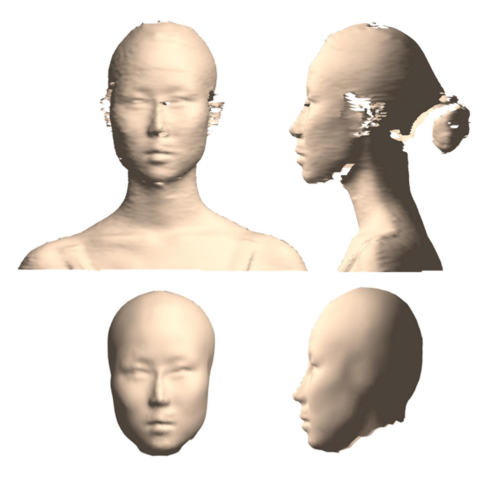
2.2 Development of a database of template-model registered heads
제안된 hybrid TMR 방법은 사이즈 코리아(n = 13,469)와 CAESAR (n = 4,235)의 3차원 머리 스캔 이미지들에 적용되었다. 선행 연구(Lee et al., 2020b)는 사이즈 코리아 사업을 통해 2004년부터 2014년 사이(5차 및 6차 치수측정사업)에 수집된 7~77세의 한국인 남녀 8,536명의 머리(Korean Agency for Technology and Standards (KATS), 2004; KATS, 2010)에 hybrid TMR을 적용하여 템플릿 정합 이미지 데이터베이스를 구축하였다. 본 연구는 동일한 방법을 적용하여 사이즈 코리아 사업을 통해 2013~2014년 사이에 수집된 데이터(6차 치수측정사업) 중 누락된 484명의 머리, 2020년부터 2021년 사이(8차 치수측정사업)에 수집된 한국인 남녀 4,449명의 머리(KATS, 2021), 그리고 CAESAR 데이터에 포함된 서양인 남녀 4,235명의 머리(Robinette et al., 2002)에 hybrid TMR을 적용하였다. 구축된 템플릿 정합 이미지 데이터베이스의 인종별, 성별, 그리고 연령대별 표본의 분포는 Table 1과 같다.
|
DB |
Sex |
<20 |
20s |
30s |
40s |
50s |
60s |
≥70 |
Total |
|
Size Korea |
Female |
766 |
520 |
519 |
275 |
243 |
182 |
89 |
2,594 |
|
Male |
764 |
519 |
512 |
262 |
252 |
173 |
88 |
2,570 |
|
|
Size Korea |
Female |
450 |
208 |
202 |
198 |
208 |
201 |
315 |
1,782 |
|
Male |
573 |
234 |
203 |
198 |
212 |
209 |
445 |
2,074 |
|
|
Size Korea |
Female |
0 |
853 |
676 |
468 |
262 |
231 |
0 |
2,490 |
|
Male |
0 |
817 |
478 |
290 |
150 |
224 |
0 |
1,959 |
|
|
Size Korea (subtotal) |
Female |
1,216 |
1,581 |
1,397 |
941 |
713 |
614 |
404 |
6,866 |
|
Male |
1,337 |
1,570 |
1,193 |
750 |
614 |
606 |
533 |
6,603 |
|
|
CAESAR |
Female |
130 |
625 |
468 |
517 |
364 |
116 |
0 |
2,222 |
|
Male |
127 |
570 |
489 |
422 |
309 |
92 |
3 |
2,013 |
|
|
Total |
Female |
1,346 |
2,206 |
1,865 |
1,458 |
1,077 |
730 |
404 |
9,088 |
|
Male |
1,464 |
2,140 |
1,682 |
1,172 |
923 |
698 |
536 |
8,616 |
|
|
Total |
2,810 |
4,346 |
3,547 |
2,630 |
2,000 |
1,428 |
940 |
17,704 |
3.1 Initial model generation
형상 기반의 백분위 대표인체모델 생성은 4단계의 절차로 진행된다. 먼저, 본 연구에서 제안된 hybrid TMR 방법을 이용하여 일관적인 mesh 구조를 가진 템플릿 정합 이미지들을 생성한다. 템플릿 정합 이미지들을 구성하는 각 vertex (v)의 3차원 위치들은 사람에 따라 특정 분포를 갖는다. 가령, 코의 형상을 구성하는 여러 vertex들 중 n번째의 특정 vertex ()는 코의 길이, 너비, 높이 등에 따라 사람마다 3차원 좌표값들(x, y, z)이 서로 상이하다. 따라서, 모든 m명의 사람들에 대해 n번째 vertex의 군집(
, Figure 4.a)의 평균 위치(
, Figure 4.c)가 계산될 수 있다. 둘째, 원점(O, Figure 4.b)과 n번째 vertex의 평균 위치(
)를 지나는 직선(
, Figure 4.d)을 생성하고, 모든 m명의 사람들에 대한 해당 vertex들(
)을 직선 (
에 투영(projection)한다(Figure 4.e). 셋째, n번째 직선에 투영된 m개의 vertex 군집(
={
})과 원점 간의 직교 방향의 Euclidean 거리 측면에서 해당 vertex의 k분위 위치(
)가 파악된다(Figure 4.f). 마지막으로, 직선 (
에 투영된 모든 n개의 vertex들(
)의 특정 백분위 위치(
={
})를 삼각 mesh로 연결함으로써 해당 백분위 크기를 가진 대표 형상이 생성된다.
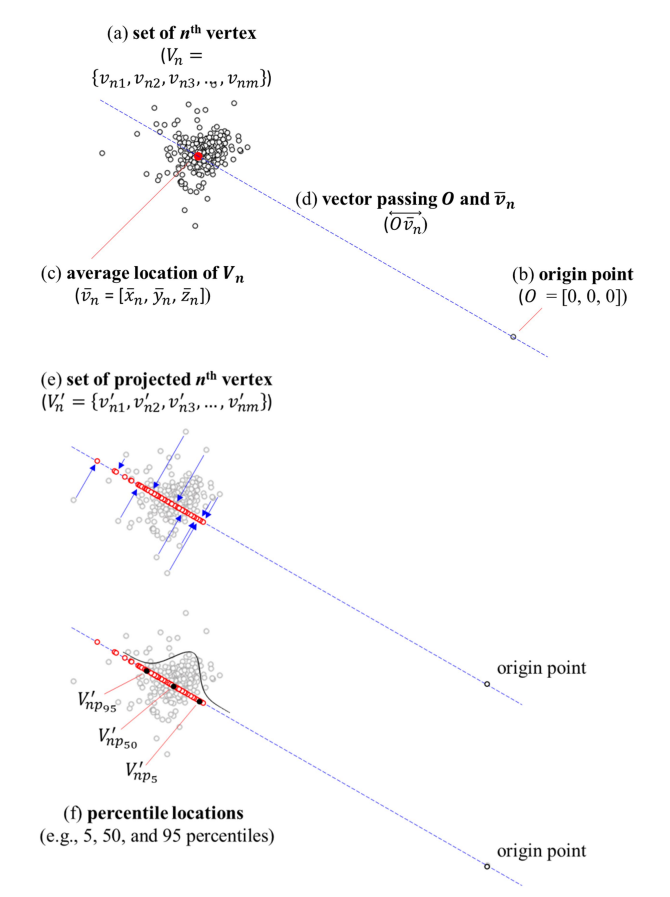
3.2 Size adjustment
생성된 백분위 대표인체모델의 세부적인 형상이 인체치수 측면에서의 해당 백분위 값을 참조하여 조정된다. 제안된 방법에 따라 생성된 백분위 대표인체모델의 형상은 직선 (에 투영된 vertex들({
})의 위치 측면에서 특정 백분위 값을 가지나, 인체치수 측면에서는 특정 백분위 값을 보이지 않을 수 있다. 그 이유는 백분위 대표인체모델의 형상이 원점과 vertex 군집의 평균 위치(
)를 연결하는 직선 (
상에서 파악되기 때문이다.
의 위치가 (
에서부터 떨어져 있는(즉,
와
간의 간격) 정도는 백분위 대표인체모델의 인체치수가 실제 측정치와 상이한 정도와 유관하다. 따라서, 여러 사람들에 대해
와
간의 변동성이 클수록 백분위 대표인체모델의 치수와 인체측정치의 백분위 값 간에 차이가 커질 수 있다. 예를 들어, 얼굴너비는 TMR된 머리 이미지를 구성하는 2,989번째와 3,005번째 vertex(얼굴옆점; zygion) 간의 x 좌표의 차이로서 계산되며, 한국인 남성(8차 치수측정사업, N = 1,959)의 얼굴너비는 평균 143.6mm(SD: 5.8, 범위: 125.1~159.2mm), 5분위 = 134.3mm, 10분위 = 136.4mm, 50분위 = 143.5mm, 90분위 = 151.1mm, 95분위 = 153.3mm를 보인다. 한편, 제안된 방법으로 생성된 5분위, 10분위, 50분위, 90분위, 95분위 대표 모델에서 2,989번째와 3,005번째 vertex 간의 x 좌표의 차이(즉, 얼굴너비)를 계산하면 5분위 모델: 130.7mm, 10분위 모델: 133.0mm, 50분위 모델: 141.8mm, 90분위 모델: 150.4mm, 95분위 모델: 152.9mm의 치수를 보인다. 치수 차이(얼굴너비 측정치의 백분위 값 - 백분위 대표인체모델의 얼굴너비)는 5분위 = 3.6mm, 10분위 = 3.4mm, 50분위 = 1.7mm, 90분위 = 0.7mm, 95분위 = 0.4mm를 보였다(Table 2).
|
Target percentile |
Percentile values of anthropometric |
Measurements of |
Difference (A - B) |
|
p5 |
134.3 |
130.7 |
3.6 |
|
p10 |
136.4 |
133.0 |
3.4 |
|
p50 |
143.5 |
141.8 |
1.7 |
|
p90 |
151.1 |
150.4 |
0.7 |
|
p95 |
153.3 |
152.9 |
0.4 |
본 연구는 hybrid TMR 방법에 사용된 형상 변형(deformation) 방법인 BBW를 적용하여 특정 인체측정항목들 측면에서 백분위 대표인체모델의 치수가 해당 인체측정항목의 백분위 값과 동일하게 되도록 백분위 대표인체모델의 형상을 조정하였다. 백분위 대표인체모델의 참조점의 위치를 조절함으로써 해당 참조점을 이용하는 인체측정항목의 치수가 특정 백분위 값을 갖게 할 수 있는데, 이 때 참조점의 주변 vertex들이 참조점과 함께 이동(2.1장 참조)하면서 백분위 대표인체모델의 형상이 다소 변형된다. Figure 5는 초기 생성된 50분위 대표인체모델(a)과 Lee et al. (2013)이 제안한 반면 마스크(half-face mask) 설계 관련 인체측정항목들인 얼굴길이(face length), 얼굴너비(face width), 코뿌리-입술밑길이(sellion to supramentale length), 코길이(nose length), 코뿌리너비(nasal root breadth), 코뿌리높이(nasal root protrusion), 코너비(nose width), 코높이(nose protrusion), 입너비(lip width) 측면에서 50분위값을 가지도록 형상이 변형된 모델(b) 간의 형상 차이를 예시한다.
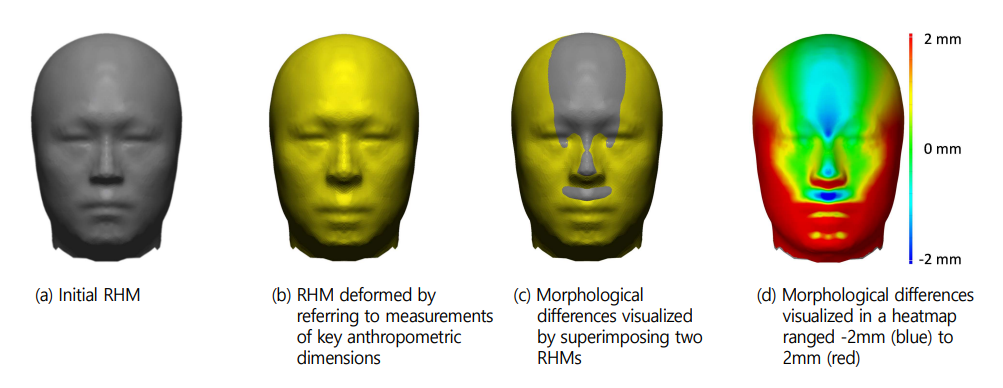
Figure 6은 한국인(KATS, 2021) 남성(N = 1,959)과 여성(N = 2,490) 및 서양인(Robinette et al., 2002) 남성(N = 2,013)과 여성(N = 2,222)의 5분위, 50분위, 그리고 95분위의 두상을 예시하고 있다. 본 연구에서 제안된 방법에 따라 초기 대표인체모델들을 생성한 후, Lee et al. (2013)이 제안한 산소마스크 설계 유관 인체측정항목들(얼굴길이, 얼굴너비, 코뿌리-입술밑길이, 코길이, 코뿌리너비, 코뿌리높이, 코너비, 코높이, 입너비)의 5분위, 50분위, 95분위 치수를 참고로 하여 초기 대표인체모델들의 형상을 조정하였다(Figure 6).
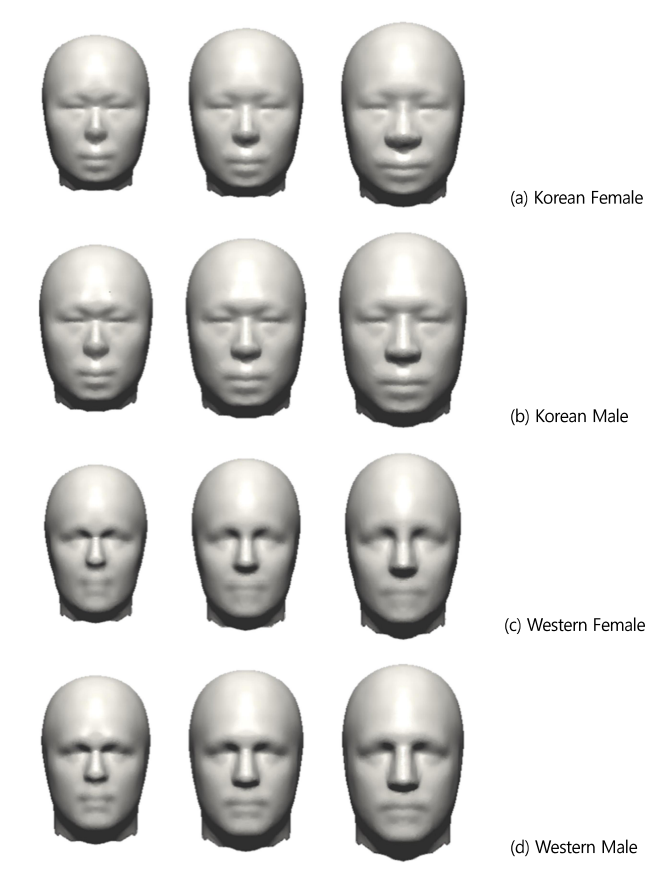
5.1 Contributions
본 연구는 제안된 형상 기반 백분위 대표인체모델 생성 방법은 기존 대표인체모델 생성 방법에 비해 크기 및 형상 측면에서의 대표성을 제고한다. 전통적인 치수 기반의 대표인체모델 생성 방법은 DB에 포함되어 있는 표본 중에서 치수 측면에서 대표인체모델에 가까운 사람을 선발하므로 특정 중요인체변수들에 대해서는 대표성을 가질 수 있지만, 중요도가 낮은 인체변수들에 대해서는 대표성을 가지기 어렵다(Lee et al., 2019; Lee et al., 2016). 또한, 착용형(wearable) 제품을 설계함에 있어 인체측정항목으로 정의되기 어려운 형상적 특징(예: 부위별 곡률)에 대한 고려가 필요한데, DB에 포함된 특정 인물로서 정의되는 전통적인 치수 기반의 대표인체모델들은 형상 측면에서의 대표성을 가진다고 말하기 어렵다(Jung et al., 2021b). 반면, 본 연구는 모든 DB에 들어 있는 사람들의 형상을 이용하여 TMR 이미지 데이터를 만들고, 이를 기반으로 대표인체모델을 계산학적으로 생성함으로써 대표인체모델들의 형상적 대표성을 제고할 수 있었다. 대표 모델들의 대표성은 인체 치수 측면에서 검증될 수 있는데, 본 방법은 대표 모델의 크기가 실제 측정치와 같거나 유사하게 되도록 형상을 수정하는 방법으로 대표인체모델들의 세부적인 크기에 대한 대표성을 확보할 수 있었다.
본 연구에서 제안된 방법은 대표인체모델들 간의 형상적 일관성을 제고하므로, 여러 치수로 제작되는 제품들의 설계에 활용도가 높을 것으로 기대된다. 사람마다 인체 크기 및 형상 특성이 매우 상이하므로, 전통적인 방법인 일부 중요인체치수들을 기반으로 선택된 대표인체모델들(예: 소, 중, 대)은 상호 형상적 일관성이 고려되기 매우 어렵다(Figure 1). 반면, 제안된 백분위 대표인체모델 생성 방법은 대표 모델들 간의 형상적 일관성을 갖도록 하므로 여러 치수로 설계되는 제품 설계에 활용되기에 용이하다. 한편, 본 연구는 크기 측면에서 대표인체모델의 대표성을 제고하기 위하여, 초기 생성된 백분위 대표인체모델의 특정 인체 부위의 인체치수들이 특정 측정치를 갖도록 해당 부위의 형상을 조절하는 방법을 제안하였다. 이러한 방법으로 특정 제품의 설계를 위한 대표인체모델을 생성할 때, 제품 설계에 유관한 중요 인체 부위들(예: 안경형 제품 설계 시 눈, 콧대, 귀 부위)만 크기적 대표성을 가지도록 조절하고, 제품 설계에 중요도가 낮은 인체 부위(예: 안경형 제품 설계 시 입과 턱 부위)의 형상은 미세하게 조절하지 않더라도 기본적으로 대표인체모델들 간의 형상적 일관성은 제고될 수 있다. 제품에 따라 조정되는 인체 부위가 상이하므로 같은 DB를 이용하여 생성된 같은 백분위의 대표인체모델이라고 하더라도 분석하고자 하는 제품에 따라 그 형상이 상이할 수 있다.
5.2 Applications and Future Studies
본 연구에서 제안된 방법은 다양한 인체 형상들을 직선(linear)적으로만 분석하므로, 다양한 유형의 인체 형상을 분석하는 방법에 관한 고려가 필요하다. 제안된 방법에 의하면, 형태가 조절되기 전의 초기 대표인체모델의 크기는 원점(O)과 특정 vertex ()의 평균(
)을 지나는 vector
를 따라 직선적(linear)으로 커지거나 작아진다. 이 때,
에 포함된 점들이
로부터 멀리 떨어져 있을수록(Figure 4.2),
와
(
에 투영된
) 간의 차이가 커질 가능성이 있다. 이러한 변동성은 생성된 대표인체모델의 대표성에 error로서 반영될 수 있으며, 이 error는 회귀선에 직교한 잔차(perpendicular residual)와 비슷한 개념으로 최소자승법에 의해 정량화될 수 있다. 변동성을 줄이고 error를 최소화하기 위한 다음과 같은 추후 연구가 고려될 수 있다. 먼저, 인체 형상의 형상적 유형(예: 얼굴이 좁은 체형, 얼굴이 넓은 체형)을 구분(Lee et al., 2017b)한 후, 해당 유형 내에서 본 방법을 적용함으로써 형상들 간의 변동성을 줄일 수 있을 것으로 판단된다. 또한, 본 연구는 원점과 vertex 군집의 평균을 지나는 직선(
)을 따라 특정 분위의 대표인체모델을 생성하였으나, 원점을 지나는 직선이 아닌 vertex 군집의 x, y, z 좌표들을 이용한 회귀선이나 PCA의 고유벡터(eigenvector)를 이용하는 등의 다른 방식을 통해 생성된 직선을 이용하여 백분위 대표인체모델을 생성할 수 있을 것이다. 그러나, 선형회귀분석의 경우 일부 vertex 군집에 대해 뚜렷한 선형적 특성을 보이지 않고 회귀모형의 결정계수가 낮은 양상을 보이기도 하여, 회귀선을 이용한 백분위 대표인체모델의 특정 부위 형상이 부자연스럽게 생성될 수 있다. 한편, TMR된 이미지의 각 vertex 군집의 x, y, z 좌표를 이용한 PCA 결과로서, 각 vertex에 대한 주성분별 고유벡터들을 대표인체모델 생성에 이용할 수 있을 것이다(Lee et al., 2017a; Lee et al., 2017b; Luximon et al., 2012a). 가령, 코를 구성하는 vertex들은 코의 길이, 코의 너비, 코의 높이 등을 설명하는 주성분(principal component)들을 가질 수 있는데, 이 주성분들의 고유벡터에 점들을 투영함으로써 인체 유형별 대표인체모델이 생성될 수 있다. 이 때, 각 주성분이 가지는 설명력에 의해 대표인체모델의 대표성이 정량화될 수 있을 것이다.
형상 기반 백분위 대표인체모델들은 인간공학적 제품의 설계에 요긴하게 활용될 것으로 기대된다. Figure 7은 안경형 제품의 설계를 위하여 생성된 백분위 대표 얼굴에 귀와 목을 이어 붙이고 품질을 높인 후, 제품 디자이너들이 CAD 소프트웨어에서 활용할 수 있도록 NURBS (non-uniform rational b-splines) 데이터로 변환한 사례이다. 본 방법으로 생성된 대표인형상들은 크기와 형상 측면에서 높은 대표성을 제고하므로, 이들을 활용하여 설계된 제품이 수용할 수 있는 인구 집단의 범위가 넓을 것으로 기대된다. 또한, 본 연구의 선행연구(Kwon et al., 2022)가 제안한 유한요소분석(finite element analysis)을 이용한 가상 착의(virtual fit) 시뮬레이션을 활용하면, 생성된 대표인체모델을 이용하여 인체와 제품의 물성치를 고려한 최적의 제품 형상을 설계할 수 있을 것으로 기대된다.

본 연구는 인간공학적 제품 설계에 적용하기 위한 형상 기반으로 대표인체모델을 생성하는 기법을 제안하였다. 전통적인 대표인체모델 생성 방법들은 일부 중요인체변수만을 이용하여 다양한 3차원 스캔 이미지들 중에 소수 명의 사람을 선발하는 반면, 본 연구에서 제안한 형상 기반 백분위 대표인체모델 생성 방법은 많은 양(예: 17,700여 명의 머리)의 3차원 인체형상들을 모두 활용하여 계산적인 방법으로 대표인체모델들을 생성한다. 이를 통해 생성된 대표인체모델들은 대표성이 높고 여러 크기의 대표인체모델들 간에 형상적 일관성을 가지므로 제품의 인간공학적 설계에 적용하기에 보다 더 적합할 것으로 기대된다.
References
1. Allen, B., Curless, B. and Popović, Z., The space of human body shapes: reconstruction and parameterization from range scans. Acm Transactions on Graphics, 22(3), 587-594, 2003.
Google Scholar
2. Anguelov, D., Srinivasan, P., Koller, D., Thrun, S., Rodgers, J. and Davis, J., SCAPE: Shape completion and animation of people. Acm Transactions on Graphics, 24(3), 408-416, 2005.
Google Scholar
3. Baek, S.Y. and Lee, K., Parametric human body shape modeling framework for human-centered product design. Computer-Aided Design, 44(1), 56-67, 2012.
Google Scholar
4. Ball, R., Shu, C., Xi, P., Rioux, M., Luximon, Y. and Molenbroek, J.F.M., A comparison between Chinese and Caucasian head shapes. Applied Ergonomics, 41(6), 832-839, 2010.
Google Scholar
5. Besl, P.J. and McKay, N.D., A method for registration of 3-D shapes. IEEE Transactions on Pattern Analysis and Machine Intelligence, 14(2), 239-256, 1992.
6. Chu, C.H., Tsai, Y.T., Wang, C.C.L. and Kwok, T.H., Exemplar-based statistical model for semantic parametric design of human body. Computers in Industry, 61(6), 541-549, 2010.
Google Scholar
7. Jacobson, A., Baran, I., Popović, J. and Sorkine-Hornung, O., Bounded biharmonic weights for real-time deformation. Communications of the Acm, 57(4), 99-106, 2014.
Google Scholar
8. Jung, K., Choi, Y., Lee, B., You, H. and Kwon, O., A Boundary Zone Method for the Generation of Multivariate Representative Humanoids. Applied Sciences, 11(8), 2021a.
Google Scholar
9. Jung, S.H., Lee, W., Kim, D.U., Kim, G.E. and Ju, Y., "Generation of percentile human models based on 3D body scan database". In Proceedings of 12th International Conference on Applied Human Factors and Ergonomics, New York, 2021b.
10. Korean Agency for Technology and Standards (KATS). The Report on the 5th Size-Korea (Korean Body Measurement and Investigation). Seoul, Korea: Size Korea, Korea Agency for Technology and Standards, 2004.
11. Korean Agency for Technology and Standards (KATS). The Report on the 6th Size-Korea (Korean Body Measurement and Investigation). Seoul, Korea: Size Korea, Korea Agency for Technology and Standards, 2010.
12. Korean Agency for Technology and Standards (KATS). The Report on the 8th Size-Korea (Korean Body Measurement and Investigation). Seoul, Korea: Size Korea, Korea Agency for Technology and Standards, 2021.
13. Kwon, Y.J., Kim, J.G. and Lee, W., A framework for effective face-mask contact modeling based on finite element analysis for custom design of a facial mask. Plos One, 17(7), 2022.
Google Scholar
14. Lee, B., Jung, K. and You, H., Development of a distributed representative human model generation and analysis system for multiple-size product design. Journal of the Ergonomics Society of Korea, 30(5), 683-688, 2011.
Google Scholar
15. Lee, B., Lee, W., Yang, X., Jung, K. and You, H., Development of a distributed representative human model generation and analysis system (DRHM-GAS): Application to optimization of flight suit and pilot oxygen mask sizing systems. International Journal of Industrial Ergonomics, 72, 261-271, 2019.
Google Scholar
16. Lee, W., Development of a design methodology of pilot oxygen mask using 3D facial scan data. (Doctoral dissertation). Pohang University of Science and Technology, Pohang, South Korea, 2013. Retrieved from http://postech.dcollection.net/jsp/common/ DcLoOrgPer.jsp?sItemId=000001628149.
Google Scholar
17. Lee, W., Goto, L., Molenbroek, J.F.M. and Goossens, R.H.M., "Analysis methods of the variation of facial size and shape based on 3D face scan images". In Proceedings of Human Factors and Ergonomics Society 61st Annual Meeting, Austin, TX, 2017a.
Google Scholar
18. Lee, W., Goto, L., Molenbroek, J.F.M., Goossens, R.H.M. and Wang, C.C.L., "A shape-based sizing system for facial mask design". In Proceedings of 5th International Digital Human Modeling Symposium, Bonn, Germany, 2017b.
Google Scholar
19. Lee, W., Jeong, J., Park, J., Jeon, E., Kim, H., Jung, D., Park, S. and You, H., Analysis of the facial measurements of Korean Air Force pilots for oxygen mask design. Ergonomics, 56(9), 1451-1464, 2013.
Google Scholar
20. Lee, W., Jung, D., Park, S., Kim, H. and You, H., Development of a virtual fit analysis method for an ergonomic design of pilot oxygen mask. Applied Sciences, 11(12), 2021.
Google Scholar
21. Lee, W., Jung, H. and You, H., Application of 3D human body template model for ergonomic product design. Journal of the Ergonomic Society of Korea, 39(3), 223-241, 2020a.
Google Scholar
22. Lee, W., Jung, H. and You, H., Development of a 3D template-registered image database of Korean heads for ergonomic product design. Journal of the Ergonomics Society of Korea, 39(5), 437-451, 2020b.
23. Lee, W., Lee, B., Yang, X., Jung, H., Bok, I., Kim, C., Kwon, O. and You, H., A 3D anthropometric sizing analysis system based on North American CAESAR 3D scan data for design of head wearable products. Computers & Industrial Engineering, 117, 121-130, 2018.
Google Scholar
24. Lee, W., Yang, X., Jung, H., You, H., Goto, L., Molenbroek, J.F.M. and Goossens, R.H.M., Application of massive 3D head and facial scan datasets in ergonomic head-product design. International Journal of the Digital Human, 1(4), 344-360, 2016.
Google Scholar
25. Li, P., Carson, J., Parham, J. and Paquette, S., "Digital human modeling pipeline with a 3D anthropometry database". In Proceedings of 5th International Conference on Applied Human Factors and Ergonomics (AHFE), Los Angeles, CA, USA, 2017.
Google Scholar
26. Li, P., Corner, B., Hurley, M., Powell, C. and LaFleur, A., Three-dimensional (3D) analysis of knee shape for designing a knee-pad. Procedia Manufacturing, 3, 3689-3693, 2015.
Google Scholar
27. Luximon, A., Zhang, Y.F., Luximon, Y. and Xiao, M., Sizing and grading for wearable products. Computer-Aided Design, 44(1), 77-84, 2012a.
Google Scholar
28. Luximon, Y., Ball, R. and Justice, L., The 3D Chinese head and face modeling. Computer-Aided Design, 44(1), 40-47, 2012b.
Google Scholar
29. Nerot, A., Skalli, W. and Wang, X., A principal component analysis of the relationship between the external body shape and internal skeleton for the upper body. Journal of Biomechanics, 49(14), 3415-3422, 2016.
Google Scholar
30. Robinette, K.M., Blackwell, S., Daanen, H., Boehmer, M., Fleming, S., Brill, T., Hoeferlin, D. and Burnsides, D., Civilian American and European Surface Anthropometry Resource (CAESAR) Final Report, Volume I: Summary. Wright-Patterson Air Force Base, OH: Human Effectiveness Directorate, Crew System Interface Division, AFRL-HE-WP-TR-2002-0169, 2002.
Google Scholar
31. Xi, P. and Shu, C., Consistent parameterization and statistical analysis of human head scans. Visual Computer, 25(9), 863-871, 2009.
Google Scholar
32. Yu, Y., Benson, S., Cheng, W., Hsiao, J., Liu, Y., Zhuang, Z. and Chen, W., Digital 3-D headforms representative of Chinese workers. The Annals of Occupational Hygiene, 56(1), 113-122, 2012.
Google Scholar
33. Zhuang, Z., Benson, S. and Viscusi, D., Digital 3-D headforms with facial features representative of the current US workforce. Ergonomics, 53(5), 661-671, 2010.
Google Scholar
34. Zhuang, Z., Shu, C., Xi, P., Bergman, M. and Joseph, M., Head-and-face shape variations of U.S. civilian workers. Applied Ergonomics, 44(5), 775-784, 2013.
Google Scholar
PIDS App ServiceClick here!